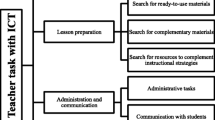Abstract
This study draws upon qualitative data to examine children's understanding of computers and how they work. The study involved interviewing a sample of 10 and 11 year old pupils in two primary schools. The results showed that children who have experience of ICT in the home as well as the school have a better understanding of the computer system and its functions. These children drew analogies of computers to related activities. Those with no computer access at home had limited knowledge of what computers are used for.
Similar content being viewed by others
References
Clough, E. E. and Driver, R. (1985a) What do children understand about pressure in fluids? Research in Science and Technological Education, 3(2), 133–144.
Clough, E. E. and Driver, R. (1985b) Secondary students' conceptions of the conduction of heat: Bringing together scientific and personal views. Physics Education, 20, 176–182.
Cox, M. and Rhodes, V. (1990) Are microcomputers used successfully in primary schools? Information Technology and Learning, 171–173.
Crawford, K., Neve, L., Pearson, M., and Bridget, S. (1999) Creative Tensions and disrupted routines: The impact of the Internet on primary children's understanding of the world. Paper presented at the British Educational Research Association Annual Conference, 2-5 September 1999.
Driver, R. (1981) Pupils' alternative frameworks in Science. European Journal of Science Education, 3(1), 93–101.
Driver, R., Asoko, H., Leach, J., Mortimer, E., and Scott, P. (1994) Constructing scientific knowledge in the classroom. Educational Researcher, 23, 5–12.
Driver, R., Leach, J., Miller, R., and Scott, P. (1996) Young People's Images of Science. Open University Press, Buckingham.
Duit, R., Goldenberg, F., and Niedderer, H. (1991) Research in Physics learning: Theoretical issues and empirical studies. Proceedings of an International Workshop. IPN, Kiel.
Driver, R. and Oldham, V. (1986) A constructivist approach to curriculum development in Science. Studies in Science Education, 13, 105–122.
Downes, T. (1996) The computer as a toy and tool in the home: Implications for schools and teachers. Education and Information Technologies, 1, 191–201.
Engel, M. E. T. (1982) The development of understanding of selected aspects of pressure, heat and evolution in pupils aged between 12 and 16 years. Unpublished Ph.D. thesis, University of Leeds.
Hewson, P. W. (1982) A case study of conceptual change in special relativity: The influence of prior knowledge in learning. European Journal of Science Education, 4(1), 61–78.
Holloway, L. S. and Valentine, G. (2001) “It's only as stupid as you are” children's and adults' negotiation of ICT competence at home and at school. Social and Cultural Geography, 2(1), 26–41.
Hornsey, M. and Horsfield, J. (1982) Pupils' discussion in Science. A stratagem to enhance quality and quantity. School Science Review, 63, 763–767.
Johnson, K. (ed) (1990) Interactive Teaching in Science: Workshops for Training Courses. Association for Science Education, Hatfield.
Kirkman, C. (1993) Computer experience and attitudes of 12-year-old students: Implications for the UK national curriculum. Journal of Computer Assisted Learning, 9, 51–62.
Martin, C. D. (1991) Stakeholder perspectives on the implementation of micros in a school district. In Case Studies in Computer Aided Learning, R. L. Blomeyer, Jr. and C. D. Martin (eds), The Falmer Press, London.
Newton, P., Driver, R., and Osborne, J. (1999) The place of argumentation in the pedagogy of school science. International Journal of Science Education, 21(5), 553–576.
Novak, J. D. and Godwin, D. B. (1984) Learning How to Learn. Cambridge University Press, New York.
Nussbaum, J. and Novick, S. (1982) Alternative frameworks, conceptual conflict and accomodation: Toward a principled teaching strategy. Instructional Science, 11, 183–200.
Pearson, M. and Somekh, B. (2000) Concept mapping as a research tool: A study of primary children's representations of ICT. British Educational Research Association, Cardiff, http://www.leeds.ac.uk/educol/newnews. htm.
Piaget, J. (1973) The Child's Conception of the World. Paladin, London.
Posner, G., Strike, K. A., Hewson, P. W., and Gertzog, W. A. (1982) Accomodation of a scientific conception: Toward a theory of conceptual change. Science Education, 66(2), 211–227.
Selwyn, N. (1998) The effect of using a home computer on student's educational use of IT. Computers and Education, 31, 211–227.
Sere, M. (1982) A case study of some frameworks used by pupils aged 11-13 years in the interpretation of air pressure. European Journal of Science Education, 4(3), 299–309.
Shipstone, D. M. (1984) A study of children's understanding of electricity in simple D.C. circuits. European Journal of Science Education, 6(2), 185–198.
Solomon, J. (1983) Is Physics easy? Physics Education, 18, 155–160.
Viennot, L. (1979) Spontaneous reasoning in elementary dynamics. European Journal of Science Education, 1, 205–222.
Author information
Authors and Affiliations
Rights and permissions
About this article
Cite this article
Mumtaz, S. Children's Conceptions of Information Communications Technology. Education and Information Technologies 7, 155–168 (2002). https://doi.org/10.1023/A:1020357811148
Issue Date:
DOI: https://doi.org/10.1023/A:1020357811148




